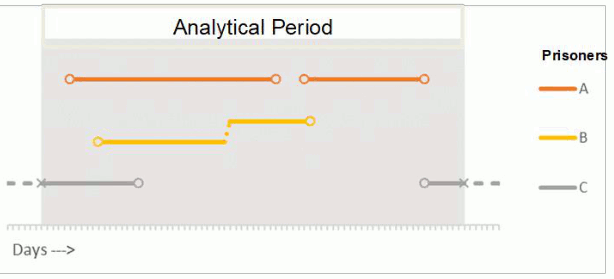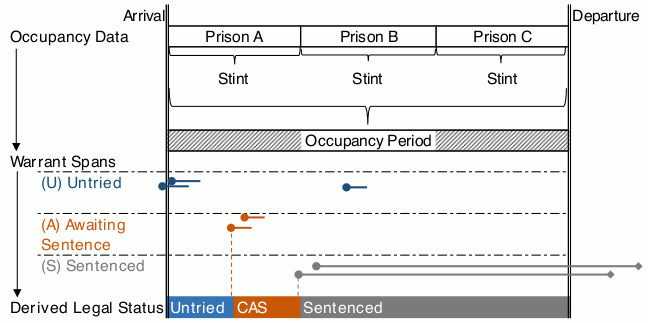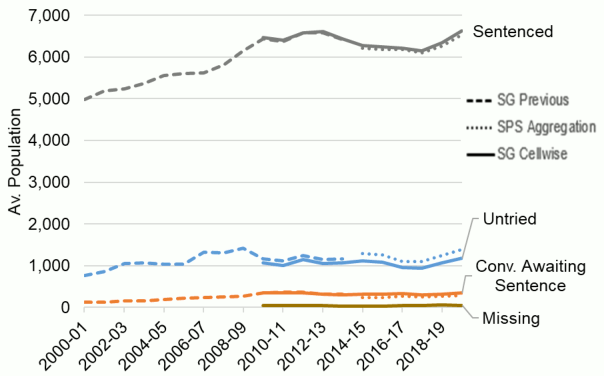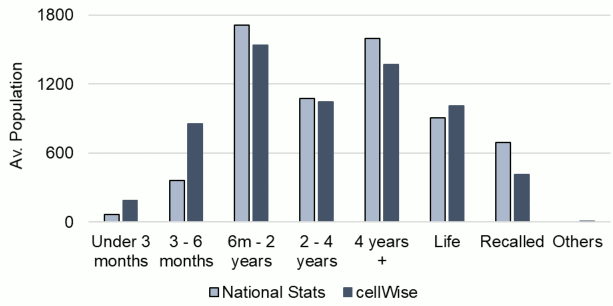Scottish Prison Population Statistics: Legal Status, 2019-20
Experimental prison population statistics covering the period 2009-10 to 2019-20, expanding on the previous publication with information about legal statuses, sentences and offences.
5 Technical Annex
5.1 Data Words
Stint
As defined in SPPS 2020, a stint is a continuous cell allocation in a specific prison establishment.
Occupancy Period
A series of consecutive stints, where the entry date of the second is equal to the exit date of the first (and so on).
Arrival and Departure
A prisoner arrival is a stint that begins on a separate day from the previous departure for that prisoner. An Occupancy Period begins with an arrival and ends with a departure.
Warrant
Information provided by the Scottish Courts and Tribunals Service indicating the basis for and (in the case of determinate sentences) duration of a stay in prison
Warrant span
The duration attributed to the effect of a warrant. For warrants without a stated length – i.e. those that do not define a determinate – remand warrant are given a standard span of 10 days. Sentenced warrant spans are equal to the length of the sentence. Life sentence warrants spans are effectively infinite. Note that this attribute is not necessarily the same as sentence length, and is used soley to attached warrants to occupancy periods.
5.2 Determining Prison Occupancy: the “cellwise” method
The most complete record of a prisoner’s presence in a prison establishment that is retained in sufficient detail historically on the SPS management information system (known as PR2) is the occupancy by prisoners of specific cells in the estate.
A stint in prison is defined as the period in which a prisoner has an allocated cell (or series of cells) in an SPS establishment. A worked example is given in Figure 33. In this example, Prisoner A has two stints within an analytical period, represented by the dates that the cell was allocated to them and subsequently de-allocated.
Where a prisoner moves between cells but not between establishments, the stints are combined into a single, continuous period of occupancy in that establishment, as with Prisoner B below. Movements between establishments are kept separately to allow for prison-level analysis of the population.
For statistics within a defined time period (annual, quarterly, monthly), only presence within that period is counted. Prisoner C also has two stints in prison: they entered prison before the period began and the second stint ends after the analytical period. Only the days served in the analytical period are counted towards their weight in the annual average statistics; days served afterwards are out of scope.

A prisoner’s occupancy (in days) within an year provides each prisoner with a weight for analysis. For example the average population over a year across the prison estate is the total number of prisoner days served, divided by the number of days in that year.
When calculating the length of a stint, some edge cases exist: for example when a prisoner enters and leaves prison on the same day. Since the time of entry and exit are not recorded in these data, this would count as zero prisoner days, and therefore zero weight. To account for this, such stints are given a value of 0.25 prisoner days (6 hours) by default.
5.3 Sequencing Warrants
Information on cell occupancy is supplemented here with information held on warrants issued to the SPS in respect of accused and convicted individuals during the course of criminal proceedings.
Based on this combined data, a number of new measurements of the prison population become possible. These are designed to be internally consistent and comparable across time and between population segments.
A number of steps are required to link the previously derived occupancy data with information held on PR2 about legal status, offences, sentences, etc.
1. The spine of this dataset is the cellwise occupancy data derived in the previous publication
2. From that spine, the occupancy periods are derived based on continuous occupancy in any SPS establishment
3. Warrant spans are derived, based on the start and (nominal) end date of each warrant held on PR2.
4. Warrant spans are joined to occupancy periods by date overlap
5. The first warrant of each type defines the start of that legal status within each period
Legal statuses in each period are determined one-directionally, from Untried (U) to Awaiting Sentence (A) to Sentenced (S). Subsequent warrants of a lower level do not change the legal status. E.g. once the sentenced period of an occupancy period starts, it remains sentenced until departure. Figure 34 provides an illustration of this, where an Untried warrant span occurs halfway through the occupancy period but does not change the derived legal status.

The new cellWise dataset has been designed to provide comparison against previous sources for context, although the measurements being made are often rather different. Figure 35 provides a comparison between the three sources available to us on the legal status of prison populations since the financial year 2000-01. There are small but clearly systematic discrepancies between sources where they overlap.
For the average daily untried population, the cellWise data under-estimates the size of the population compared with the previous SG Official Statistics and compared with the continuity statistics from SPS aggregation. It (cellWise) also overestimates the sentenced population to a very small degree.
The convicted awaiting sentence (CAS) population is slightly underestimated by cellWise compared with the Official Statistics, and overestimates it relative to SPS aggregations. This is certainly a result of the single direction hierarchy necessarily applied to legal statuses in the course of a period in prison, where the first warrant with the CAS status changes the overall legal status irreversibly until the first sentenced warrant is lodged.

5.4 Determining time on remand
Time within an occupancy period may then be divided into three broad types of occupancy in prison:
- U: Untried: Unconvicted individuals held in prison awaiting court proceedings
- A: Convicted Awaiting Sentence: Time spent convicted of an offence but awaiting a sentence. Sometimes shortened to “CAS”.
- S: Sentenced: Time spent in prison with a custodial sentence. This includes individuals with determinate sentences, life sentences or those recalled to prison after previously being released.
It should be noted that U- or A-time indicates the length of a period after the first designation in each category, before entering a subsequent status. With the available data it has not been possible to attribute backwards movement through the U-A-S hierarchy. Some prisoners may, after completing a sentence, remain in prison awaiting trial or sentencing or additional offences. This is evident in occupancy periods ending in a sentenced status being liberated “On Bail”, or other liberation types associated with remand prisoners.
We are not able to attribute the times spent on remand at the end of sentenced occupancy periods with the current data design.
Each warrant has several associated dates. For this build the most important are:
- the warrant issue date – the date the warrant was provided by the Court
- the warrant start date – the date from which the warrant was effective
5.4.1 Sequencing Dates
For sentencing warrants in particular, a start date can pre-date its issue date. This is often the situation where a prisoner has spent a period on remand which counts towards the service of their subsequent sentence.
For the purpose of sequencing, the full effective period of a warrant – its span – is used to associate warrants to occupancy periods. The earlier of the issue and start date defines the first date in a warrant span.
5.4.2 Legal Status Transitions
When we seek to attribue legal statuses to time within a period, the warrant issue date is used to show the contemporaneous effects of the warrant.
This more accurarely reflects the results of a snapshot on any given day, and the separation of populations in prisons (as remand prisoners are required to live separately from people serving a sentence).
5.4.3 End Dates
PR2 is a live system, providing in-depth information about the prison population at the time it is consulted. Some information is retained when it ceases to be active on the current prison population, whic allows us to produce the retrospective statistics in this and previous bulletins.
Some information that would be useful for this purpose, however, is not reliabley retained. This is the case for the effective end dates of warrant records. As a result we have needed to make some assumptions about warrant spans.
Untried/CAS: We have assumed a 10-day duration on warrants with this legal status. This allows a margin for error in associating them with occupancy periods, i.e. where a remand warrant is registered prior to the individual being admitted.
Determinate Sentences: The full duration of a sentence is used to associate sentencing warrants with occupancy periods. This is one option for attributing an end date, and a known counterfactual.
All else being equal, prisoners on determinate sentences can generally expect to serve half to two-thirds of their sentence before being considered for parole. This provides is the second option for attributing an end date.
There are pros and cons to both options. Applying the full length of a determinate sentence could result in a period on remand being “over-written” in error by a pre-existing sentence. However, using only a proportion of the sentence length to define the warrant span resulted in a large number of periods where durations could not be attributed to a legal status or offence.
Since prisoners can be recalled from parole for breach of conditions and return to serve out the remainder of that sentence, the longer span is preferable to applying a rule of thumb based on likely service.
Given that the remand estimates provided by cellwise are largely in line with that of other sources, misattribution of remand time to sentenced would appear to be a relatively small effect.
Life Sentences: Life sentences (of all types) are attributed with an effectively infinite determinate length. Any life sentenced prisoner who is released may be returned to prison for a variety of reasons. Regardless, they will continue to be classed as a life sentenced prisoner on their return.
Further work is again required to gather the full information about the basis for life recalls. In these statistics, life sentenced and life recall prisoners are accounted for together under the index offence based on all sentenced warrants (including the life sentences) associated with thei occupancy period.
5.5 Index Offences
People are often incarcerated for a number of offences at once.
Due to the structure of the warrant file in PR2, it is not always possible to disentangle which offences are active or inactive at what stage of an occupancy period.
We therefore provide statistics on Index Offences, which are determined at occupancy period level. Index offences are intended to represent the most serious offence for which a prisoner is incarcerated.
5.5.1 Sentenced Index Offences
For the collated sentencing warrants applicable over an occupancy period, we must pick the index offence based on the following prioritisation:
1. the offence associated with a life sentence
2. where there are no life sentences, the offence associated with the longest determinate sentence
3. where multiple offences have the same sentence, the index offence is the offence associated with the longest average sentence length, as shown in Table 7
There are several uncertainties introduced into our reckoning as a result.
- Individuals may be sentenced for a less serious offence first, and spend several months serving that sentence while awaiting trial, receiving the heavier sentence later in the occupancy period. Particularly where the occupancy periods overlap multiple years, we may therefore over-count certain offences in-year when compared with custodial sentence statistics from criminal proceedings statistics[23]
- Individuals might serve a series of consecutive sentences for lesser offences. It may appear that individuals remain in prison for extended periods for what looks like a single, lesser offence. However this extended period might be justified by multiple instances of offending.
- Offence categories are quite broad, and there is a good deal of variability in sentence lengths for the 35 offence groups. The average sentence length is arguably a poor measure of the actual severity of each of these categories taken together.
5.5.2 Remand Index Offences
Where warrants do not have associated sentences, the determination of the index offence is based solely on the average sentence for each category, as shown in Table 7. Average sentence is provided by Criminal Proceedings statistics[24].
| Scottish Government Top 35 Offence Category | Ordered by Average Length |
|---|---|
| 1 Homicide etc. | 1 |
| 5 Rape and attempted rape | 2 |
| 4 Other non-sexual crimes of violence | 3 |
| 2 Attempted murder and serious assault | 4 |
| 6 Sexual assault | 5 |
| 3 Robbery | 6 |
| 8 Other sexual crimes | 7 |
| 17 Fire-raising | 8 |
| 22 Other other crimes | 9 |
| 21 Drugs | 10 |
| 9 Housebreaking | 11 |
| 20 Handling offensive weapons | 12 |
| 15 Fraud | 13 |
| 28 Dangerous and careless driving | 14 |
| 27 Other miscellaneous offences | 15 |
| 26 Urinating etc. | 16 |
| 23 Common assault | 17 |
| 11 Theft from a motor vehicle (OLP) | 18 |
| 12 Theft of motor vehicle | 19 |
| 10 Theft by opening lockfast places | 20 |
| 16 Other dishonesty | 21 |
| 18 Vandalism etc. | 22 |
| 31 Unlawful use of motor vehicle | 23 |
| 14 Other theft | 24 |
| 24 Breach of the peace etc. | 25 |
| 29 Driving under the influence | 26 |
| 19 Crimes against public justice | 27 |
| 13 Shoplifting | 28 |
| 35 Other motor vehicle offences. | 29 |
| 33 Seat belt offences | 30 |
| 34 Mobile phone offences | 31 |
| 7 Crimes associated with prostitution | 32 |
| 25 Drunkenness and other disorderly conduct | 33 |
| 30 Speeding | 34 |
| 32 Vehicle defect offences | 35 |
5.6 Index Sentence Length
Determining the overall length of sentence a prisoner is serving in a given occupancy period has not been possible with these data.
On arrival to prison, an officer calculates the overall sentence length of the prisoner individually based on a combination of the sentences they arrive with. This includes information from the Court about whether sentences are to be served consecutively or concurrently. This information is not transferred to PR2 and therefore cannot be used in our calculations. Overall sentence length can also change over the course of a period in prison, as more convictions and sentences may be forthcoming during that period.
Sentencing warrants are associated with occupancy periods as described in section 5.4.1. However, information about how these discrete records should be processed and combined is largely absent from the system.
To be able to provide some information about the sentences leading to incarceration, we have identified the longest sentence in each occupancy period as the Index Sentence Length.
Where, for example, a prisoner is serving a sentence of multiple years as a result of several consecutive shorter sentences, they will be categorised by index sentence length as the longest of those constituent sentences.
Added to this information on determinate sentences, we have included the available information about life sentences and certain recall types.
5.6.1 Validation
We can compare the distribution of prisoners by sentence length in 2013-14 from this newly build data set with the previously published statistics[25], as shown in Figure 36.

The previous statistics publication was based on a collation of daily snapshots, and therefore retained the overall sentence length information from the live PR2 system.
The following differences between sources can be observed:
- Excess of prisoners in the categories under 6 months and a dearth of those in the longer sentence length categories. This is likely a direct result of our inability using the cellWise data to reliably combine sentences, whether consecutively or concurrently
- Excess of life prisoners: Life sentences are given precedence over sentences in the cellWise build, and may legitimately over-ride determinate sentenced stints for some prisoners.
- Dearth of recalled prisoners: Recall is given precedence in this categorical description over determinate sentence lengths. Individuals recalled to custody may quickly complete their sentence on recall then transition to an alternative sentence or remand group. This subsequent movement would not be detected, as described in section 5.3
As a result of these shortcomings in the utility of these data, we cannot say that the newly constructed data reflect the population in the same way as the previous data set. Throughout this report we therefore refer to the “index” sentence, rather than overall sentence length, to differentiate these two different metrics.
5.6.2 Life Sentences
Life sentences are persistent: they continue to be in effect even after a prisoner is liberated. When an individual returns to custody after a period at liberty, for whatever reason, if they were previously given a life sentence they will continue to serve it. This life sentence will continue to be the longest sentence they are serving, and the offence associated with the life sentence will continue to be classed as their index offence.
Due to the persistence of life sentences, some of the warrant data associated with older life sentences has been lost.
Information about the life sentence type (standard life sentence or OLR) is retained on a separate table and used to identify life sentences where warrant information is missing,
Where there is evidence of a life sentence being served, but the original warrant is absent from the system, the index offence will be classed as ‘(Missing)’.
5.6.3 Recalls
Two types of recall are included in the index sentence band categories from Prisoners and Criminal Proceedings (Scotland) Act 1993:
- Section 17 Revocation of Licence
- Section 18 Breach of Supervised Release Order
The presence of such recall warrants in an occupancy period places prisoners in the recall category for that period. Where possible, the offence associated with the original period in custody is provided as the index offence.
Where a prisoner is also subject to a life sentence, that life sentence takes precedence in both the index sentence categorisation and the index offence.
5.7 Recorded Liberations
When a prisoner leaves prison and is not expected to return under the same legal basis, their liberation is recorded on the SPS management information system.
We have made a distinction here between “departures” – defined as a stint in prison ending and not immediately followed by a further stint – and “liberations”, where an individual has finished their period in custody and is released. A person in prison can have multiple departures and liberations within a year if they are released for short periods but subsequently return. Where a departure coincides with a Liberation record (+/- 1 day) that departure is counted as a Liberation. Where no Liberation is available, they are simply counted as departures.
If a liberation record does not coincide with a departure, it is not included in these statistics. Similarly liberations to court are not included here – they generally occur in the middle of a stint in prison, after which a person would return to prison at the end of the day.
| Expected Status On Liberation | Summary Liberation Type | Full Liberation Description |
|---|---|---|
| Sentenced | Sentence Served | Lib Sent. Exp. |
| On licence/Parole/SRO/HDC | HDC | |
| Lib On Licence | ||
| Lib On Parole | ||
| Lib To S.R.O | ||
Appeal/Pardon |
Lib On Appeal | |
| Pardon | ||
| Fine Paid | Lib Fine Paid | |
| Remand | Bailed | To Bail |
Court/PF |
Court | |
| Lib From Court | ||
| Proc. Fiscal | ||
| Ambiguous | Immigration/Deportation | Lib Imm. Author |
| Lib Dungavel DC | ||
| Deported | ||
| Repatriation | ||
| Lib To E.R.S | ||
Other |
Deceased | |
| Lib To Mental Hosp | ||
| Lib To List D | ||
| Local Authority | ||
| Discretionary Early Release | ||
| Gender Reassignment | ||
| Lib To Interlib | ||
| Police Int'view |
People who have died in prison are counted in the “Other” category above. Deaths in custody are the subject of Scottish Prison Service reporting, available on the SPS website: https://www.sps.gov.uk/Corporate/Information/PrisonerDeaths.aspx
5.8 Postcode Quality
SPS is in the process of working backwards through prisoner records to improve the quality of postcode information held on PR2 in collaboration with data officers at the individual establishments across the prison estate.
One of the steps being taken is to apply the postcode of Council offices to people with no fixed abode. This process is currently incomplete, however future data releases will be able toinclude people of no fixed abode in the Local Authority disaggregated statistics.
Aside from records for prisoners of no fixed abode, many postcodes remain incomplete and therefore unmatchable to broader geographic characteristics. A further data improvement exercise by PR2 system administrators is in train, and the number of postcodes which cannot be matched is likely to fall as this proceeds.
The records marked as being “Address Outwith Scotland” leverage information from the “country” part of the address data where the supplied postcode cannot be matched. This group includes only records where the country is recorded as specific administrations in the UK (England, Wales, Northern Ireland) or non-UK countries, but does not include those cases where the country is given as “UK”, i.e. unspecified. Cases with unmatchable postcodes and where the country provided is either Scotland or is unspecified are gathered together under the “Unknown Address” category.
| Financial Year | Total Arrivals | Known LA | No Fixed Abode | Unknown Address | Address Outwith Scotland |
|---|---|---|---|---|---|
| 2010-11 | 20,721 | 19,176 | 915 | 615 | 15 |
| 2011-12 | 20,958 | 19,305 | 947 | 696 | 10 |
| 2012-13 | 19,071 | 17,547 | 899 | 610 | 15 |
| 2013-14 | 19,306 | 17,759 | 976 | 558 | 13 |
| 2014-15 | 18,540 | 16,958 | 1,002 | 557 | 23 |
| 2015-16 | 17,905 | 16,260 | 1,069 | 527 | 49 |
| 2016-17 | 16,446 | 14,861 | 994 | 527 | 64 |
| 2017-18 | 15,324 | 13,813 | 980 | 480 | 51 |
| 2018-19 | 15,595 | 14,095 | 997 | 413 | 90 |
| 2019-20 | 14,324 | 12,825 | 1,072 | 129 | 298 |
Total Arrivals: The number of times someone arrives in prison in the period. Includes counting of multiple arrivals per person.
Known LA: The postcode provided by the person arriving in prison matches a known address in Scotland, allowing the derivation of further geographical information
No Fixed Abode: The person self-identifies as have no fixed abode on entry to the prison
Unknown Address: A postcode has been provided which cannot be matched.
Outwith Scotland: A postcode has been provided which cannot be matched AND the individual has supplied the country of their address as being outwith Scotland
Contact
Email: jamie.robertson@gov.scot
There is a problem
Thanks for your feedback